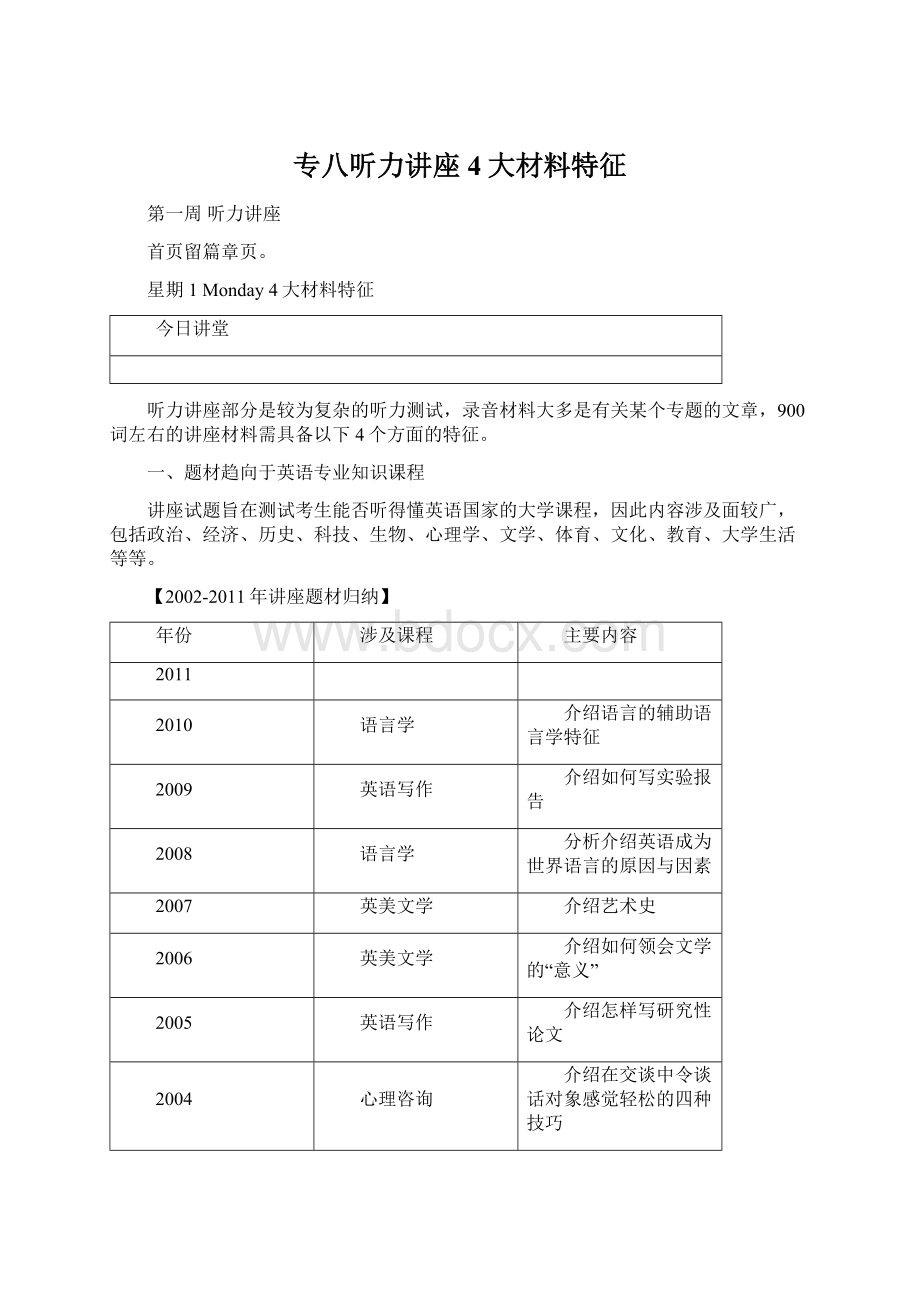专八听力讲座 4大材料特征.docx
《专八听力讲座 4大材料特征.docx》由会员分享,可在线阅读,更多相关《专八听力讲座 4大材料特征.docx(21页珍藏版)》请在冰豆网上搜索。

专八听力讲座4大材料特征
第一周听力讲座
首页留篇章页。
星期1Monday4大材料特征
今日讲堂
听力讲座部分是较为复杂的听力测试,录音材料大多是有关某个专题的文章,900词左右的讲座材料需具备以下4个方面的特征。
一、题材趋向于英语专业知识课程
讲座试题旨在测试考生能否听得懂英语国家的大学课程,因此内容涉及面较广,包括政治、经济、历史、科技、生物、心理学、文学、体育、文化、教育、大学生活等等。
【2002-2011年讲座题材归纳】
年份
涉及课程
主要内容
2011
2010
语言学
介绍语言的辅助语言学特征
2009
英语写作
介绍如何写实验报告
2008
语言学
分析介绍英语成为世界语言的原因与因素
2007
英美文学
介绍艺术史
2006
英美文学
介绍如何领会文学的“意义”
2005
英语写作
介绍怎样写研究性论文
2004
心理咨询
介绍在交谈中令谈话对象感觉轻松的四种技巧
2003
心理学
介绍亚伯拉罕·马斯洛的人类需求理论
2002
英语写作
介绍大学学习中的一些学习活动,如写论文和进行专题讨论
从上面的归纳可以看出,2005年之后讲座的选材趋向于突出英语专业知识课程的内容,我们预测今后此题型的选材涉及的范围会包括英美文学、英美国家概况、语言学、跨文化交际、英语教学法、英语写作等等专业知识课程。
二、“总―分―总”的语篇模式
分析历年真题讲座,我们可以将其语篇模式总结为“总―分―总”的宏观模式。
讲话人开门见山,一开始便点出将要在讲座中谈论的问题,这是全文的核心,即“总”。
然后对跟这些问题有关的方面逐一进行详细论述,即“分”。
最后部分为结束语,以结论性的语言结束讲座,又是“总”。
【例1】(2010年)
结构
内容
说明
总
Goodmorning,everyone.Todaywe’llcontinueourdiscussionondescribinglanguage.Lastweekweexamined…Inthislecture,we’lllookatanotherimportantaspectoflanguage...Itreferstofeaturesofcommunicationthattakesplacewithouttheuseofgrammarandvocabulary.Theyarecalled“paralinguisticfeaturesoflanguage”.Thesefeaturesfallintotwobroadcategories…
讲座的开始就明确指出主题是语言问题,在复习上周讲座的主题后,总述这次讲座主要介绍副语言特征,并且指明它包括两大类。
分
Now,thefirstcategoryiswhatwecall“vocalparalinguisticfeatures”.Thefirstis…Thesecondis…Thelastis…
Now,let’scometothesecondcategory—physicalparalinguisticfeatureswhichinvolvesthebody….First,facialexpression.Facialexpressionisapowerfulconveyerofmeaning.
Thesecondinthiscategoryisgesture.
Thethirdisproximity,postureandechoing.
中间部分将两大类一一进行阐述。
在介绍语音特征时举了五个例子,在介绍第二类副语言特征,即肢体的副语言特征时,从三个方面进行介绍。
总
Ok,intoday’slecture,welookedatsomeparalinguisticfeatures,suchastoneofvoice,gestureandposture.Thesefeatures…areallpartofthewaywecommunicatewitheachotherinface-to-faceencounters.Inournextlecture…
最后以结论性的语言再次总结这次讲座的主题,然后提到下次讲座的内容。
三、运用提示语
比较杂志与讲座中所用的语言,我们会注意到讲座会对所要听的内容给出清楚的指示。
这些指示即可称为“提示”,它们引导考生去听一些东西。
具体而言,又可以分为以下三个方面的提示:
1.主题提示
主题提示预示一个主题的导入。
具体提示方式又有以下三种:
具体的主题提示。
例如:
Let’slookat…
Todaywe’regoingtotalkabout…
Ok,let'smoveonto…
修辞性问句作主题提示。
例如:
Youmightask…well…howoldtheresearchersjudgepsychologicaldistress?
以陈述句的口吻用一两个词语总结将要讲的信息作主题提示。
例如:
OK.Definitions.
【历年真题主题提示语归类】
年份
主题提示方式
提示语
2011年
2010年
具体的主题提示。
Todaywe'llcontinueourdiscussionondescribinglanguage.
2009年
具体的主题提示。
Todaywe’lldiscusssomepreliminariesconcerninghowtowriteexperimentalreport.
2008年
具体的主题提示。
Today’slectureisaboutthepopularityofEnglish.
2007年
修辞性问句作主题提示。
…SoI’dliketospendsometimediscussingwithyouthefollowingtopic:
Whydoweneedtostudyarthistory?
Andwherecanwelearnfromit?
2006年
修辞性问句作主题提示。
Howdoweknowwhataworkofliteratureissupposedtomean?
Orwhatitsrealmeaningis?
2005年
修辞性问句作主题提示。
Thenwhatiswritingaresearchpaperlike?
Howarewegoingtowriteone?
Whatarethestepsinproducingaresearchpaperandwhatarethepointsweneedtotakecareof?
2.结构提示
类似于作者写作时总是考虑怎样组织观点才能最清晰地表达观点,讲座报告人也在讲座的结构中运用这些提示,帮助听众理解讲座的观点,以及观点之间的联系。
常见的结构提示以及提示语归类如下:
分类
目的
提示语
下定义
讲座人的目的在于对术语进行定义。
Now,Xmeans(isthewordfor)…
ByX,Imean(meant,referredto)…
WhenIusedX,Imeant(wasreferringto)…
WhatdoImeanbyX?
HowcanwedefineX?
分类列举
通过分类将主题分成若干子话题,同时还对各子话题进行列举。
Xcanbedivided/subdivided/brokendown/classifiedinto2(3,4etc.)
Thereare2(3,4etc.)typesof/divisionsof/classificationsofX.
Thefirst(second,etc.)pointis…
Numberone(two,etc.)…
First(Second,etc.)ofall…
描述因果关系
描述各事物间的因果关系,一起事件导致(或可能,或应该导致)一起或多起事件的发生。
Duetothefactthat/Becauseof…
Since…
(Now)thisisdueto…
…andthereasonforthisis…
Thus/Therefore/Consequently/Forthesereasons,…
HowcanIexplainthisto…?
Whyisthisthecase?
例证主题
报告人的目的是通过举例来说明主题。
Forexample/Forinstance/Toillustrate/Inthiscase,…
Takesomethinglikethis…
Inmoreconcreteterms,…
描述过程或事件的顺序
按照事情的过程或事件发生的顺序组织信息,以便说明事情是怎样发生的。
First(Secondetc.),…
Next(Then,Subsequently,Later,Afterthat,etc.),…
Priorto(Previously,Beforethat,etc.),…
Inordertoarriveatthispoint,wehadto…
Let’slookathowthiscameabout/wherethiscomesfrom./(thestepsinvolvedin)thisprocess.
描述特点
通过介绍特点来描述物体或生物,尤其重视事物的物理性质与结构。
ConcerningX’sappearance,…
Let’slookatX’sphysicalmakeup.
Xismadeupof…
Xlooks/acts/feels/smells/sounds/tasteslike…
比较与对比
通过比较与对比事物之间的异同,报告人可以先谈论各个事物,然后进行比较、对比。
But/However,…
Ontheotherhand,…
Onthecontrary/Conversely,…
Similarly/Likewise,…
Alongthesamelines,…
Inthesamefashion/manner,…
Again,…
【例2】(2010年)
Now,thefirstcategoryiswhatwecallvocalparalinguisticfeatures.Vocalfeaturesareactuallytonesofvoice.…Thefirstiswhispering…Thesecondisbreathiness.…Thethirdishuskiness,…Thefourthisnasality...Thelastisextralip-rounding,….
Now,let'scometothesecondcategory,physicalparalinguisticfeatures,whichinvolvesthebody.First,…Thesecondinthiscategoryis…Thethirdis…
【分析】上面讲座的主体部分结构方式以分类列举为主,报告人将主题分成若干个子话题讲述,同时听众也能通过Thefirst,thesecond,thethird等提示语跟随报告人的思路记下笔记。
3.主题结论提示
大多数讲座以结论性语言来结束。
可能包括回顾重点内容;使用概括性的语言将主题的不同侧面有机地联系起来;也可能讨论所谈主题的后果。
同时,报告人还会简单提示下一个讲座的内容。
【例3】(2010年)
Ok,intoday'slecture,welookedatsomeparalinguisticfeatures,suchastoneofvoice,gestureandposture.Thesefeatures,togetherwithlinguisticfeaturesoflanguage,likegrammar,orvocabulary,areallpartofthewaywecommunicatewitheachotherinfacetofaceencounters.Inournextlecture,we'llwatchsomevideomaterial,andseehowpeopleactuallyuseparalinguisticmeansincommunicationtoexpresstheirintentionordesireormood.
【分析】本讲座结束语前一部分Welookedat…回顾了重点内容,同时Therefeatures一句将主题的不同侧面有机地联系起来;最后部分Inournextlecture则简单介绍了下一个讲座的目的。
四、运用解释、重复、举例、离题信息
写作时,一个观点作者只需要陈述一遍,因为读者可以反复阅读,想读多少遍就多少遍。
而在听的时候,人们常常“左耳朵进,右耳朵出”,所以报告人要给听众一定的时间来对他们所听到的内容进行整理或记笔记。
为达到这一目的,报告人可以重新用不同的话语阐述某一定义或观点(即解释)、用完全相同的词语重复、或用更多的细节来扩展观点(如举例)。
此外,讲座中突然改变主题或跑题的现象(离题信息)要比文章中的多一些,因为讲座是现场活动,报告人在讲话时也许会说一些事先没有考虑过的想法。
讲座报告人重新阐述、重复和举例并不增加新观点,而是留给听者更多时间来理解其观点。
报告人离题时,听者可以尽快分辨出来,权且把离题内容当作长时间记笔记过程中的一次轻松愉快的休息。
【例4】(2010年)
Now,thefirstcategoryiswhatwecall“vocalparalinguisticfeatures”.Vocalfeaturesareactuallytonesofvoice.Whiletheyare,perhaps,notcentraltomeaningincommunicationinthesamewayasgrammarorvocabulary,theymay,nevertheless,conveyattitudeorintentioninsomeway.Letmegiveyousomeexamples.Thefirstwhispering,whichindicatestheneedsforsecrecy.Thesecondisbreathiness.Thisistoshowdeepemotion.Thethirdishuskiness,whichistoshowunimportance.Thefourthisnasality.Thisistoindicateanxiety.Thelastisextralip-rounding,whichexpressesgreaterintimacy,especiallywithbabies,forexample.Sowecanseethatthereareanumberofwaysofalteringourtonesofvoice.Andwhenwedothisconsciously,wedoittocreatedifferenteffectsincommunication.
讲座中首先谈到副语言特征的第一类即是语音特征,其后给出了定义,Vocalfeaturesareactuallytonesofvoice…theymay,nevertheless,conveyattitudeorintentioninsomeway,即语音特征是指语调在某种方式上能够表达态度或意愿。
其次,此段中通过表示语音特征的关键词词vocal,features,tonesofvoice,communication等的重复,表达了句子之间的承接关系。
而且,在介绍语音特征时列举了五个例子,而且用Thefirstis…Thesecondis…Thethirdis…Thefourthis…Thelastis…连接而成,行文逻辑清楚明了。
今日练习
Mini-Lecture1
下面内容排在表格内,左列原文,右列题号与下划线,注意左右序号基本对齐。
ConsiderationsofLearning-centeredTeaching
I.Introduction
A.goalofmostcourses:
toenhancestudents’understanding
——differentunderstandingcallsfordifferentteachingmethods
B.mostformsofunderstandingareexpressedbynew
(1)
——example:
“weight”for“heaviness”
C.otherkindsoflearningbesidesunderstanding
1.thekeylearningactivity:
(2)
2.memorizingandrecalling(3)
3.acquiringattitudesandvalues,ect.
——differentlearningcallsfordifferentteachingmethods
II.Waysofcategorizationandmodelingstudents
A.holists:
studentswhoviewa(4)asawhole
B.serialists:
studentswhobeginatthe(5)
C.visualisers:
studentswhodependonvisualmaterials
D.verbalisers:
studentswhoprefertolisten,read,discuss,ect.
E.(6):
studentswhobelievethattopracticeistounderstand
III.Students’approachestolearning
A.(7)approach:
intendingtofurtherunderstandingandquestionideas.
B.(8)approach:
intendingtomemorizeinformationandobey
IV.Courseevaluationthroughfeedback
A.feedbackrevealaboutthelearnersandthecourseor(9)
B.feedbackcanbequite(10)unlessproperlyanalyzed
(1)_______
(2)______
(3)______
(4)______
(5)______
(6)______
(7)______
(8)______
(9)______
(10)______
Mini-Lecture2
DealingwithLife'sStickySituations
Inourdailylife,itisunavoidablethatwerunintosomestickysituations.Ifwereactproperly,theharmcanbereducedtotheminimum.
Therearewaystotackleseveralsuchsituations.
I.Sendingaincriminatinge-mailtothewrongpersonbyaccident
A.Firstofall,you’dbetter
(1)____.
B.Theywillnotbelieveyouifyousayyoudonotmeanit,soinsteadturnthesituationinto
(2)____
II.Somebodyinsultedorbadmouthedapersonyoulike
Putinmindthatneverbesilentandletitpassby,foryoursilencemightbeinterpretedas(3)_____.
III.Youspillsomethingonyourselfbutarealreadyonthewaysomewhere
A.ATideStainStickworksmiraculous
1.Ifyoudonottakeanyremedy,just(4)_____afterarrivingyourdestination.
2.Ifyoutrytopretendthereisnostainonyou,thenthestainmightbe(5)______.
Ⅳ.Youorderedfarlessthanyourfriendwhowantstogohalvies
A.Youmightbeaccusedasbeing(6)_____ifyouinsistpayyourbillonly.
B.Youshouldbestraightforwardandsayyouareonabudget.
Itisimportanttosayyouwould